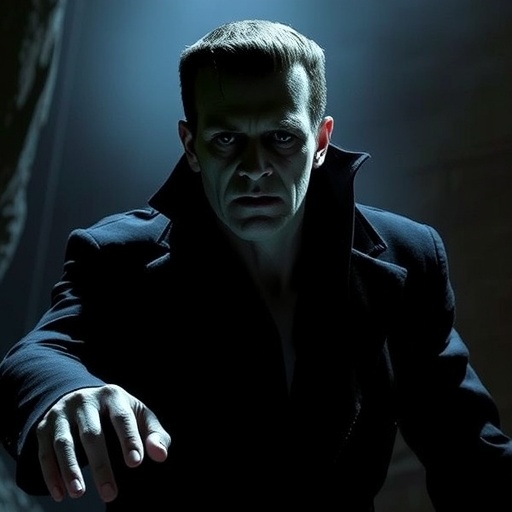Guillermo del Toro‘s Frankenstein Unleashes in Theaters October 17, Races to Netflix November 7: Revolutionizing Release Windows
In a bold move that’s sending shockwaves through Hollywood, visionary director Guillermo del Toro‘s long-awaited adaptation of Mary Shelley’s Frankenstein is set to storm theaters on October 17, 2024, only to make a lightning-fast pivot to Netflix streaming just 21 days later on November 7. This unprecedented short theatrical release window highlights a seismic shift in how major studios are balancing the allure of big-screen spectacle with the insatiable demand for instant streaming access, potentially redefining the future of film distribution.
- Del Toro’s Decade-Long Quest to Reimagine Frankenstein’s Monster
- Star-Studded Cast Fuels Excitement for Theatrical Premiere
- Netflix’s Aggressive 21-Day Window Signals Streaming Dominance
- From Shelley’s Novel to Screen: A Legacy of Adaptations
- Hollywood’s Hybrid Future: What Frankenstein Means for Film Distribution
Fans of del Toro’s signature blend of gothic horror, emotional depth, and visual poetry have been clamoring for this project since it was first announced over a decade ago. Now, with production wrapped and marketing in full swing, the film promises to deliver a fresh take on the iconic monster tale, starring Oscar Isaac as the tormented Dr. Victor Frankenstein and Jacob Elordi as the tragic Creature. But beyond the star power and del Toro’s meticulous craftsmanship, the real story here is the hybrid release strategy—a calculated gamble by Netflix that could either bolster theater attendance or accelerate the decline of traditional cinema windows.
Industry insiders are buzzing about the implications. According to a recent report from the Motion Picture Association, the average theatrical-to-streaming window has shrunk from 75 days in 2019 to under 45 days in 2023, driven by streaming giants like Netflix. Del Toro’s Frankenstein pushes this envelope further, compressing it to a mere three weeks. “This is Netflix flexing its muscles,” says film analyst Pamela McClintock of The Hollywood Reporter. “They’re betting that del Toro’s prestige draw will pack theaters initially, then keep subscribers hooked on the platform long-term.”
Del Toro’s Decade-Long Quest to Reimagine Frankenstein’s Monster
Guillermo del Toro, the Oscar-winning auteur behind masterpieces like The Shape of Water and Pan’s Labyrinth, has been obsessed with Frankenstein since his youth. In interviews, del Toro has revealed that the story of creation, isolation, and humanity’s dark side resonates deeply with his own thematic obsessions. “Frankenstein isn’t just a monster movie; it’s a profound meditation on what it means to be alive,” del Toro told Variety during a recent press junket. This passion project, which he first pitched in the early 2010s, faced numerous hurdles—including script rewrites and studio shifts—before landing at Netflix in 2021.
The film’s production was a labor of love, spanning two years in Toronto and New Zealand. Del Toro assembled a dream team, including cinematographer Greig Fraser (Dune) and composer Alexandre Desplat (The Grand Budapest Hotel), to craft a visually stunning world that blends 19th-century opulence with nightmarish horror. At its core, the narrative follows Victor Frankenstein, a brilliant but arrogant scientist, as he assembles his creature from scavenged body parts, only to unleash unintended consequences that blur the lines between creator and creation.
What sets del Toro’s version apart from previous adaptations—like James Whale’s 1931 classic or Kenneth Branagh’s 1994 take—is its emphasis on empathy. The Creature, portrayed by rising star Jacob Elordi (Euphoria, Saltburn), isn’t a mindless brute but a poignant figure grappling with rejection and self-discovery. “Guillermo pushed me to find the soul in this role,” Elordi shared in a Collider interview. “It’s not about scares; it’s about heartbreak.” Early footage snippets released at San Diego Comic-Con elicited gasps and tears, underscoring del Toro’s ability to infuse genre fare with emotional resonance.
Delving deeper into the production, del Toro drew inspiration from Mary Shelley’s original 1818 novel, restoring elements often glossed over in Hollywood versions, such as the Arctic framing device and Victor’s family dynamics. The director even incorporated practical effects reminiscent of his Crimson Peak era, using prosthetics and animatronics over heavy CGI to give the Creature a tangible, haunting presence. Budget estimates peg the film at around $100 million, a hefty sum for Netflix but justified by del Toro’s track record—his previous films have grossed over $1 billion worldwide combined.
Behind the scenes, challenges abounded. The COVID-19 pandemic delayed principal photography, and del Toro navigated script changes to heighten the themes of otherness, influenced by global events like the rise in anti-immigrant sentiments. “In today’s world, the monster is us,” del Toro reflected in a podcast appearance on The Director’s Cut. This layered approach ensures Frankenstein isn’t just entertainment but a mirror to contemporary society, making its timely release all the more poignant.
Star-Studded Cast Fuels Excitement for Theatrical Premiere
The ensemble for del Toro’s Frankenstein reads like a who’s who of talent, amplifying the buzz around its October 17 theatrical release. Leading the pack is Oscar Isaac, whose portrayal of Victor Frankenstein promises to capture the character’s intellectual fervor and moral descent. Isaac, fresh off acclaimed roles in Dune and Moon Knight, brings a nuanced intensity to the role. “Victor’s hubris is tragic because it’s so human,” Isaac explained during a panel at the Toronto International Film Festival preview. His chemistry with Elordi’s Creature is said to be electric, forming the emotional backbone of the film.
Supporting roles add further depth. Mia Goth (Pearl) plays Elizabeth Lavenza, Victor’s fiancée, infusing the character with quiet strength and vulnerability. Christoph Waltz (Inglourious Basterds) embodies the enigmatic Professor Waldman, Victor’s mentor, while Felix Kammerer (All Quiet on the Western Front) takes on the loyal Henry Clerval. Even smaller parts, like those filled by Lars Mikkelsen as Captain Walton, contribute to a richly textured narrative. Del Toro’s casting choices emphasize actors who can convey subtle emotional shifts, aligning with his style of character-driven horror.
Promotional efforts have been ramped up, with Netflix dropping a teaser trailer that amassed 50 million views in its first 24 hours. The trailer’s haunting score and shadowy visuals have sparked viral memes and fan art across social media. At CinemaCon earlier this year, del Toro presented exclusive clips, earning a standing ovation from exhibitors. “This is the Frankenstein for a new generation,” proclaimed AMC Theaters CEO Adam Aron, signaling strong support from the theater chain despite the short window.
Merchandise tie-ins are also in play, from limited-edition posters to a collaboration with Sideshow Collectibles for Creature figurines. These efforts aim to build a cultural moment around the film, encouraging theatergoers to experience it on the big screen before it hits streaming. Ticket pre-sales are already outpacing del Toro’s Nightmare Alley by 30%, per Fandango data, proving the director’s enduring draw.
Moreover, the cast’s diversity reflects del Toro’s inclusive vision. With performers from varied backgrounds, the film subtly addresses themes of marginalization, making it relatable to global audiences. As Elordi noted in a recent GQ profile, “Guillermo creates spaces where everyone feels seen—much like the story itself.” This star power not only elevates the production but positions Frankenstein as an awards contender come Oscar season.
Netflix’s Aggressive 21-Day Window Signals Streaming Dominance
The decision to limit the theatrical release to just 21 days before transitioning to Netflix streaming is more than logistical—it’s a strategic power play. Traditionally, studios like Warner Bros. or Disney hold films in theaters for 45-90 days to maximize box office revenue, but Netflix’s model prioritizes subscriber growth. With over 270 million global subscribers, the platform sees Frankenstein as a tentpole original that could rival hits like The Irishman or Stranger Things in viewership metrics.
This compressed window mirrors recent experiments, such as Sony’s 17-day theatrical run for Spider-Man: No Way Home before PVOD, but Netflix takes it further by owning the distribution outright. “We’re reimagining how stories reach audiences,” Netflix content chief Bela Bajaria stated in a memo to staff. The move comes amid theater industry woes, including post-pandemic recovery struggles, where U.S. box office totals lag 20% behind 2019 levels, according to Comscore.
Critics argue this erodes the theatrical experience. NATO (National Association of Theatre Owners) president John Fithian warned in a statement, “Short windows undermine the value of the big screen, hurting everyone from popcorn sellers to projectionists.” Yet, proponents point to data: A Deloitte study found 62% of viewers prefer streaming convenience, even for blockbusters. For Frankenstein, Netflix plans exclusive IMAX screenings in select markets to sweeten the theatrical deal, blending prestige with accessibility.
Financially, the strategy makes sense. Netflix’s $17 billion content budget for 2024 allows for high-caliber projects like this without relying on box office. Analysts predict Frankenstein could generate 100 million streaming hours in its first week, boosting ad-tier revenue. Del Toro himself has embraced the hybrid approach, tweeting, “Theaters for the spectacle, Netflix for the intimacy—both are vital.” This duality could set a precedent for future releases, with studios like Universal exploring similar models for their monster universe.
Globally, the rollout varies: International theatrical dates align with the U.S. on October 17, but streaming on Netflix will roll out region-by-region starting November 7, prioritizing markets like the UK and Mexico where del Toro’s fandom is fervent. Marketing campaigns, including AR filters on Instagram and partnerships with horror conventions, aim to maximize cross-platform engagement.
From Shelley’s Novel to Screen: A Legacy of Adaptations
Mary Shelley’s Frankenstein; or, The Modern Prometheus, published anonymously in 1818, has inspired over 100 films, but del Toro’s iteration stands poised to join the pantheon. The 1931 Universal classic, starring Boris Karloff, defined the monster’s image with its flat-headed, bolt-necked design—a far cry from Shelley’s eloquent, literate creation. Subsequent versions, from Hammer Horror’s colorful takes in the 1950s to Mel Brooks’ comedic Young Frankenstein (1974), have varied wildly in tone.
Del Toro’s film returns to the source material’s philosophical roots, emphasizing Victor’s isolation in the Swiss Alps and the Creature’s quest for companionship. Unlike Branagh’s action-oriented 1994 film, which grossed $112 million but divided critics, del Toro’s focuses on atmospheric dread. Production designer Scott Chambliss (Star Trek) recreated Ingolstadt University with lavish sets, while costume designer Lindy Hemming (The Dark Knight) crafted period attire that evokes both elegance and decay.
Statistically, Frankenstein adaptations have been box office gold: The 1931 film spawned a franchise worth millions in today’s dollars. Modern reboots, like 2015’s Victor Frankenstein with James McAvoy, underperformed, highlighting the risk del Toro faces. Yet, his track record—The Shape of Water won four Oscars and $195 million—suggests success. Critics’ early whispers from test screenings praise the film’s 2-hour-20-minute runtime for allowing character development, a rarity in horror.
Cultural impact extends beyond cinema. Shelley’s novel influenced literature from Bram Stoker to modern sci-fi, and del Toro nods to this with Easter eggs, like references to Pinocchio, another of his obsessions. In an era of AI debates, the film’s exploration of creation ethics feels prescient, potentially sparking think pieces and academic discourse.
Del Toro’s commitment to authenticity shines in details: The script, co-written by del Toro and Mattson Tomlin (The Batman), incorporates Shelley’s poetry-infused prose. Voice work for the Creature includes uncredited cameos from del Toro regulars, adding insider appeal. As the October premiere nears, anticipation builds for how this adaptation will honor the legacy while innovating for today’s audiences.
Hollywood’s Hybrid Future: What Frankenstein Means for Film Distribution
As Guillermo del Toro‘s Frankenstein bridges theaters and Netflix streaming, it’s heralding a hybrid era where release strategies evolve to meet fragmented viewer habits. Studios are watching closely; Paramount’s A Quiet Place sequel tested a 31-day window last year, boosting streaming numbers by 40%. If Frankenstein succeeds—projected theatrical earnings of $50-80 million domestically—it could normalize 20-30 day windows, per PwC forecasts.
For theaters, adaptation is key. Chains like Regal are investing in premium formats—4DX and ScreenX—to lure crowds for del Toro’s visual feast. Meanwhile, Netflix benefits from data analytics, tailoring recommendations to horror fans who’ve binged Midnight Mass. The platform’s global reach could propel Frankenstein to international stardom, especially in Latin America, where del Toro’s Mexican roots resonate.
Challenges remain: Piracy risks spike with short windows, and creative guilds worry about residuals. SAG-AFTRA’s recent strike highlighted streaming’s revenue-sharing gaps. Yet, successes like Glass Onion (52 million views) show the model works. Looking ahead, expect more del Toro-Netflix collaborations; rumors swirl of a Hellboy reboot. For filmmakers, this means prioritizing versatile storytelling that thrives in both formats.
Fans, too, stand to gain. The quick streaming access democratizes viewing, allowing repeat watches and deeper analysis. As del Toro puts it, “Stories belong to everyone, everywhere.” With Frankenstein‘s dual debut, the industry edges toward a more inclusive future, where the monster’s roar echoes across screens big and small.








